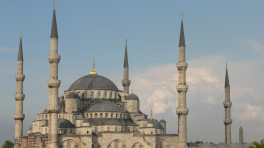Confronting architecture’s complicity with racism
In “Reconstructions” at the Museum of Modern Art, African-American designers and artists envision an architecture of Blackness that grapples with the field’s troubled history

A wheeled off-kilter black-steel framework, among the first items the visitor encounters on the third floor of the Museum of Modern Art, could be taken as an industrial remnant mounted with sails to carry it away.
A closer examination of the work — "The Refusal of Space" by architect and professor Mario Gooden — reveals it as an armature to document protests and host short videos on 1960s civil rights actions in Nashville. Its wheels evoke the trolley lines built-in 1905 by African-American businessmen in response to a law requiring segregated streetcars. White interests sabotaged the lines, forcing them to close.
In its haunting ambiguity, "The Refusal of Space" signals that MoMA's new exhibition, "Reconstructions: Architecture and Blackness in America," is not the polite parade of progress that is the standard fare of exhibits on architecture. "Mario's protest machine is about mobility," says Mabel Wilson, a professor at Columbia University's school of architecture and a co-organizer of the exhibition, which runs through May 31. "The logic of the ghetto is to limit you. It says you cannot go here, or do this. If freedom is about that ability to move, then a protest machine that is mobile is important."
Wilson and co-organizer Sean Anderson, an associate curator at MoMA's Department of Architecture and Design, concluded that the museum's first exhibition on Black architecture had to engage fundamental questions. After all, Wilson, when he searched for museum holdings at MoMA on Black architecture, came up all but empty-handed.
That is in part a legacy of department founder Philip Johnson, whose devotion to the aesthetics of architecture shut out all else. Activists have demanded that Johnson's name be removed from the gallery where "Reconstructions" is being shown, because of Johnson's white supremacist views and Nazi sympathies. While the museum considers the activists' demand, the show's artists created a fabric banner that covers up Johnson's name.

"Architecture" and "Blackness" have historically rarely found themselves in the same sentence. Architects often claim their designs are racially neutral without considering the kinds of systems and practices their buildings embody. And the field has not succeeded in its wayward efforts at inclusion over the years. African Americans currently make up only about 2% of licensed architects, according to the National Council of Architecture Registration Boards. One young architect recently told me that she was the 463rd Black woman to be licensed as an architect — ever.
The 10 installations in the MoMA exhibition, each drawn from a different city, elaborately collage and layer histories, stories, touchstones, geographies and speculations. On a screen, a montage of mainly still photos by David Hartt of Watts, in Los Angeles, adds a documentary-film quality to the exhibition by capturing moments of calm amid the heedless city cacophony. Skinny palm trees against the sky and a clump of tropical greenery bursting out of a bleak public-housing wall assert the right to beauty.
Several artists and designers addressed the spatial nature of Black oppression, Wilson says. "The plantation becomes the ghetto. Apartheid is a spatial logic. It continued with redlining, subprime mortgages, and why the pandemic hit Black and brown populations with such force."
Architect/artist Amanda Williams, for example, chose Kinloch, Missouri, a suburb of St. Louis that drew African-American residents in the early 20th century and was incorporated as the state's first Black city in 1948. In her sprawling, muralistic "We're Not Down There, We're Over Here," images collide with scrambled cartographic meridians and borders swooping in all directions, arguably smashing the neatly redlined precincts. A "space ship" of found objects hangs from the wall. "She's recognizing the refusal by Black people to be penned in," said Wilson.
The piece celebrates that self-determination but does not mourn its fate: Most residents left Kinloch when their homes were bought out by the city for a 1980s airport expansion project that was never built. Its population much diminished, much of the surviving town was bulldozed in 2015 for warehouse development. "Black space is fleeting, fleeing, taking flight, unmoored," Williams writes in the catalog — themes of people asserting agency and taking flight have defined Black America from the beginning of slavery, exhibit organizers Anderson and Wilson pointed out. (MoMA will mount another Williams installation, "Embodied Sensations" in its vast atrium, opening April 10.)

Across from Williams's piece, architect J. Yolande Daniels uses three-dimensional wireframe maps that pull apart "topographic layers of L.A. 's forgotten history," according to Anderson, in "black city: the Los Angeles Edition." She augments the maps with short, evocatively illustrated biographies of such lost places as Calle de Los Negros and the Mason Block, named for Biddy Mason, who had been a slave but became an early real-estate entrepreneur. The maps show "ghosted layers of the historic city," Anderson says. "It's acknowledging that those erasures happened and the afterlives of those erasures we are living with."
In some fashion, Anderson says, all the participants took up the curators' invitation to "re-imagine the built environment, to take the past and ask, what if?"
Some participants explored "ways of becoming black," says Wilson. "You make a space for life, for family, for fellowship, for anger, for revolt. You see how those things are entangled in all of the projects."
In Emanuel Admassu's "Immeasurability," a Waffle House restaurant sign becomes iconic by being removed from its natural habitat, the highway strip. "He is thinking about the social spaces of black life that don't typically get registered," says Wilson. Admassu describes the open-all-night diner chain that's a staple of Atlanta's highways as "an extension of the nightclub."
The Jamaican-born architect Sekou Cooke, who is based in Syracuse, New York, brought in an actual well-worn concrete stoop in "We Outchea: Hip-Hop Fabrications and Public Space." The porch, the stoop, and the street corner are the essential and human-scaled sites where African Americans invent their own social life when other public places are only intermittently available and risky.
Cooke chose Syracuse's much-contested 15th Ward, a Black neighborhood serially decimated by an interstate highway and public housing — a story many cities could tell. A planned redevelopment now promises to bring mixed-income housing to the community, potentially displacing more people. Cooke proposes to subvert it by incising the blocky, generic structures he presumes will come with shed and gable-roofed structures that introduce the porch-and-stoop past. These surgical intrusions leave behind outdoor spaces and public interiors that can host a richer public life than the lawns and parking lots of the proposed project.
Miami-based architect Germane Barnes suspends shelves of spice bottles from the ceiling for his piece, "A Spectrum of Blackness: The Search for Sedimentation in Miami." "You not only see all these different spices, you see the way Dominicans use spice versus the way Jamaicans did," says Wilson. "When Barnes, who is from Chicago, moved to Miami, he recognized that Black is multi-lingual — Creole, French, Spanish, Portuguese." Wall-hung collages, both touching and ironic, are titled "kitchen portrayals" and "porch typologies."
Three of the "Reconstructions" participants speculate on what tomorrow's urban reality could look like.
Artist Olalekan Jeyifous offers prodigiously complex and intricate dystopian visions of a New York transformed by climate change in "The Frozen Neighborhoods," computer-generated images and videos that capture the joyfully chaotic improvisation inspired by global megacities. Subway cars are stacked as dwellings on top of each other; a ticketing kiosk is repurposed as an entry to virtual worlds. Another image shows a global melange of people and vendors swarming the streets, in front of sober apartment buildings now festooned with advertising signs and bursting with plantings. A gondola glides serenely overhead.
"He's drawing on an amazing collage tradition," said Wilson. "With a few adjustments, these streetscapes could be Rio de Janeiro, Johannesburg, Lagos, or Brixton in London."
Architect V. Mitch McEwen, co-founder of the New York-based Atelier Office, uses her piece, "R: R," to ask what New Orleans might look like if the enslaved peoples' uprising of 1811 had succeeded, instead of being cruelly crushed. "She's trying to imagine a logic of what that liberation would be," says Wilson. The project envisions a city that could fit gracefully into its watery landscape, using building techniques and materials that could be made locally. Recognizing Black people have been exploited by markets rather than benefiting from them, her project shows a New Orleans whose "architecture would not be reliant on capitalist systems," says Wilson.


 Keep updated, follow The Business Standard's Google news channel
Keep updated, follow The Business Standard's Google news channel














